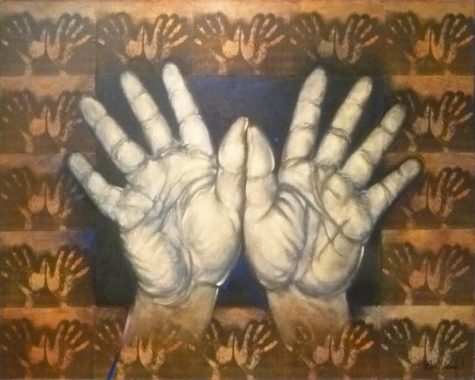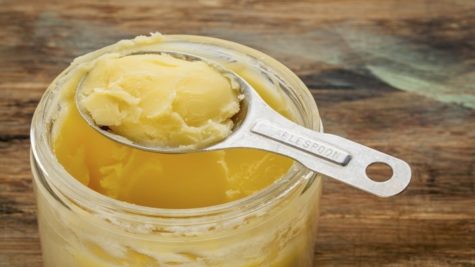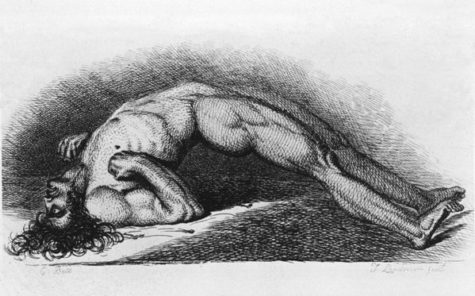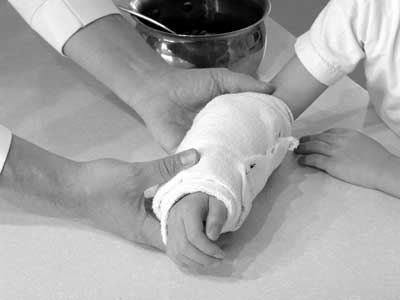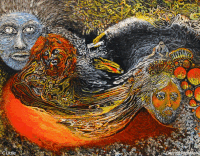Wounds
Salves To Heal Up Wounds
From Pow-Wows, or Long Lost Friend, by John George Hoffman we have these three recipes for a salve to heal up wounds:
- Tobacco and Elder
Take tobacco, green or dry; if green a good handful, if dry, two ounces; together with this take a good handful of elder leaves, fry them well in butter, press it through a cloth, and you may. use it in a salve. This will heal up a wound in a short time.
- Oak Bark and Tallow
Or go to a white oak tree that stands pretty well isolated, and scrape off the rough bark from the eastern side of the tree; then cut off the inner bark, break it into small pieces, and boil it until all the strength is drawn out; strain it through a piece of linen, and boil it again, until it becomes as thick as tar; then take out as much as you need, and put to it an equal proportion of sheep-tallow, rosin and wax, and work them together until they form a salve. This salve you put on a piece of linen, very thinly spread, and lay it on the wound, renewing it occasionally till the wound is healed up.
- Parsley and Butter
Or take a handful of parsley, pound it fine, and work it to a salve with an equal proportion of fresh butter. This salve prevents mortification and heals very fast.
Healing With The Fingertips
From Healing and Mental Purification by Hazrat Inayat Khan, we have this instruction for healing with the fingertips:
Hygiene is the first subject to consider in healing with the tips of the fingers. Hands that have been engaged in any work or that are stained with any liquid must be washed for healing. The healer must first observe the hygienic rules of keeping his body, as well as his clothes, pure and clean; especially at the time of healing he must be absolutely free from all that is unhygienic. The sleeves, at the time of healing, must be rolled back, and the fingernails must be clean and properly trimmed.
After healing, one should wave the hand, as it were shaking it, to shake off any fine atoms, or even vibrations, so that a poison taken from the painful part of the patient may not be given to the patient again.
There are cases in which the sensation of the body is deadened by the pain, and the pain has gone into the depth of the affected part of the body. In such cases waving the hand or touching is not enough. Rubbing is necessary.
When dealing with the effects of poison from the sting of a bee or scorpion, or from snake-bite or the bite of any other poisonous animal, a simple soft touch or stroking of the affected part is indicated. If the pain is more intense touch is not necessary, simply the waving of the hand close to the affected part.
In the case of the bite of a mad dog, one should put some lime, mixed with water on a copper coin and tie it on the part that the teeth have touched, and the rest of the affected part must be healed by touching and stroking it with the tips of the fingers.
Bites of mosquitoes and midges may be cured by applying butter, that has been boiled and allowed to cool, and then waving the hand over the affected part.
Rosewater may be used for bites of all kinds, in cases of severe in inflammation.
A Healing Herbal Balm
- Calendula (Calendula officinalis)
- Plantain (Plantago major)
This sweet-smelling balm soothes and protects cuts and scrapes. And it’s so gentle you can even use it on diaper rash. Calendula and plantain are known for their ability to speed skin healing. Both soften skin, relieve pain, and are antibacterial.
First make an herb-infused oil. In a large glass jar, combine the following:
- 2 tablespoons crushed Calendula flowers
- 2 tablespoons dried Plantain leaves
- 1/3 c of extra-virgin olive oil
Leave uncovered, and place in a pan filled with enough water to cover the lower half of the jar. Set the burner on very low heat and simmer gently for about 4 hours. Check the oil periodically to be sure it’s not scorching; don’t let it boil. (You can also make the infused oil in a Crock-Pot set on very low without a lid.) After the allotted time, remove the oil from the heat and allow it to cool completely. Strain away the herbs through several layers of cheesecloth and discard.
To make the balm, combine the following:
- The oil you just infused
- 1 or 2 tablespoon of grated beeswax
Put it into a small stainless steel bowl; set the bowl into a pot of water and heat just until the beeswax melts, stirring gently to help the melting. To test the consistency, insert a cool metal spoon into the balm and check the balm that sticks to the spoon; it should be spreadable but firm. If it’s too oily, add another few shavings of beeswax.
At this point, you can add a natural preservative to your balm to prevent spoilage. Vitamin E, squeezed from capsules, works very well. Rosemary extracts or oil might improve the aroma and antiseptic properties as well. You’ll need about 1/4 tsp. (two capsules) to preserve this much balm. After you’ve blended in the vitamin E, transfer your final product to a sterile glass jar. Use a clean spoon or small spatula to transfer the balm to avoid introducing bacteria to the jar.
How to use it:
Apply the balm to rashes, scrapes, and other small or superficial abrasions (don’t use it on deep cuts). You can also apply it regularly to help heal chronically chapped skin. Stored in a cool, dark place, the balm should keep for up to a year. Discard if it smells rancid.
Remedy For The Lock Jaw
We are informed by a friend that a sure preventive against this terrible disease, is, to take some soft soap and mix it with a sufficient quantity of pulverized chalk, so as to make it of the consistency of buckwheat batter; keep the chalk moistened with a fresh supply of soap until the wound begins to discharge, and the patient finds relief.
Our friend stated to us that explicit confidence may be placed in what he says, that he has known several cases where this remedy has been successfully applied. So simple and valuable a remedy, within the reach of everyone, ought to be generally known. ~N. Y. Evening Post.
From: Pow-Wows, or Long Lost Friend, by John George Hoffman, [1820]
A Soothing Wash
The bark from the most common European elm, Ulnus procera, can be used medicinally. A decoction, made by boiling 1 oz fresh, inner bark in 1 1/4 pints water until reduced by half, is an astringent, soothing wash for wounds, skin problems and for dandruff.
The fresh, bruised leaves can also be used as a healing poultice for wounds or infused and used as a rinse for scurfy skin and dandruff.
From: The Complete Book of Herbs and Spices
For information on individual herbs visit: The Encyclopedia of Herbology
Three Simple Poultices
Herbal poultices, generally made from the bruised, fresh leaves of special herbs, are frequently mixed with Slippery Elm and boiling water sufficient to give the mass consistency. Slippery Elm poultices are sticky, so enclose in a clean cloth before applying to open wounds and poisoned abscesses.
In old gangrenous wounds, an excellent antiseptic poultice is prepared by mixing with warm water or an infusion of Wormwood, equal parts of Slippery Elm powder and very fine charcoal and applying immediately over the part.
A very valuable poultice in cases where it is desirable to hasten suppuration or arrest the tendency to gangrene is made by mixing the Slippery Elm powder with brewer’s yeast and new milk.
Compound Bran poultice is made by mixing with hot vinegar equal quantities of wheaten Bran with Slippery Elm powder. This is an excellent poultice for severe rheumatic and gouty affections, particularly of the joints, synovitis etc.
Source: A Modern Herbal
For information on individual herbs visit: The Encyclopedia of Herbology
A Healing Salve
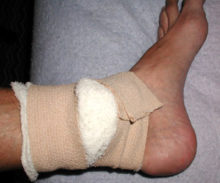 The Red Indians have long used this viscous inner bark to prepare a healing salve, and in herbal medicine a Slippery Elm bark powder is considered one of the best possible poultices for wounds, boils, ulcers, burns and all inflamed surfaces, soothing, healing and reducing pain and inflammation.
The Red Indians have long used this viscous inner bark to prepare a healing salve, and in herbal medicine a Slippery Elm bark powder is considered one of the best possible poultices for wounds, boils, ulcers, burns and all inflamed surfaces, soothing, healing and reducing pain and inflammation.
It is made as follows:
Mix the powdered bark with hot water to form the required consistency, spread smoothly upon soft cotton cloth and apply over the parts affected. It is unfailing in cases of suppurations, abscesses, wounds of all kinds, congestion, eruptions, swollen glands, etc.
In simple inflammation, it may be applied directly over the part affected; to abscesses and old wounds, it should be placed between cloths. If applied to parts of the body where there is hair, the face of the poultice should be smeared with olive oil before applying.
Source: A Modern Herbal
For information on individual herbs visit: The Encyclopedia of Herbology
Saida: Salves To Heal Up Wounds
Brenda-Lee: Egg White Cough Cure
Pat Scott: Marsh Mallow Ointment
Sharon from Cleveland, Ohio: Egg White Cough Cure
Vagabond Witch: Soapwort Shampoo

